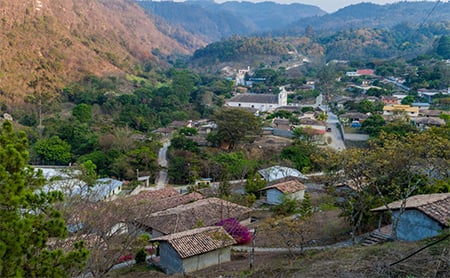An American Public Health Physician in Honduras
February 27, 2023 | Kimberlee Wyche Etheridge
 The state of healthcare in rural Honduras, where I just spent a week with 13 medical students and three other physicians, is bleak.
The state of healthcare in rural Honduras, where I just spent a week with 13 medical students and three other physicians, is bleak.
At 41, one woman came to the clinic with anxiety, poor appetite, and trouble sleeping. With much probing, we learned that her husband left for the United States with their son seven years ago. A year later, her 16-year-old daughter left by herself to try to connect with her father and brother in North Carolina—she is now grown and 23 years old. The patient has not seen her family since they left, has no way to write them, and has a phone number that only works sometimes. There are no depression or anxiety medications, and no mental health services in the area. I can only offer her medicine to help her sleep, and a consultation with the priest for prayer. This story repeated multiple times over the course of the first clinic days.
Honduras is a country of 9.5 million residents with a history that includes some of the earliest farmers and elaborate interconnected communities with sophisticated commerce routes and communications It was home to the Mayan empire, who were considered the most advanced pre-Columbian civilization in the hemisphere. Today, it is one of the poorest countries in Central America with nearly 60% of the population considered to be impoverished.
The urban cities and rural parishes are like night and day. The city looks like many others in Central America, a scene that quickly transitions when heading up the mountains. Streets are shared among farmers moving cattle, stray dogs dancing with cars to avoid getting hit, motorcycles holding sometimes three people (without helmets). Often, I have seen men weaving in and out of traffic with a woman sitting side saddle and occasionally holding an infant or young child. Injuries and violent deaths are among the leading causes of death here.
Government runs public health clinics and public hospitals. Healthcare is free in the public system, but the care is limited; families are responsible for their loved ones’ comfort, food, hygiene, and medications while in the hospital. Medicines are over the counter, requiring not a doctor’s prescription but a note listing what is needed. The cost is often prohibitive.
There are public health messages everywhere in this small rural community where we have set up our clinic. One such message is, “Yo decido cumplir mis suenos” (or “I decided to follow my dreams”)—a teen pregnancy prevention message. There is another message from the government, this one urging people to get vaccinated against COVID. Being in public without a mask is still illegal here, however there is no enforcement, and few people wear them.
Although the public health system here has many shortcomings, the strengths are impressive. Public health workers keep meticulous ledgers of all children and adults, what vaccines they have received and which chronic diseases they have, where they live, what kind of house they live in, whether the family cooks inside or outside, and other details. They set out on motorcycles to give STD test results and instruct patients to return to the clinic for treatment when necessary and they track down pregnant women who have missed an appointment.
Immunizations are given in schools along with anti-parasite medication every six months. Breastfeeding is the norm, and mosquito control is one of the top priorities as are food safety and water purity. There has been a push to educate the population about safe water. Twenty years ago, the preschool-aged child mortality rate was almost 20% in some rural areas, with the leading causes being infections and diarrheal illnesses.
Back at our clinic, a 13-year-old arrived alone. When we asked if her parents were with her, she let us know that her husband, who is 20 years old, is at the house. She did not volunteer her story. It is common for young teens to marry older men and move into the house with his family. We have seen many women in their early twenties with children ages eight and younger. We gave the 13-year-old prenatal vitamins and moved on to the next patients—we saw 500 in four days. So many stories, so much need.
Health equity is not a priority here. Rural Hondurans, who are often of Indigenous heritage, do not have the resources they need to maximize their health. Education after sixth grade is a luxury, and advanced healthcare is reserved for those who can pay or who can connect with a sponsor or medical brigade. Similar to the United States, the powerful have taken advantage of and devaluated the human worth of the poor. We often talk about the shortcomings of the U.S. public health system, but the resources available to most of us is a is remarkable success when you see the alternative firsthand.
In addition to serving as ASTHO’s Senior Vice President of Health Equity and Diversity Initiatives, Kimberlee Wyche Etheridge (“Dr. Kim,” as she is affectionately known) is also a faculty member at the Meharry Medical College in the department of pediatric and adolescent medicine.